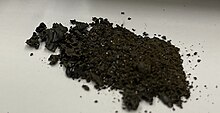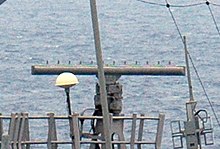이리듐 화합물
Iridium compounds| 산화[a] 상태 | |
|---|---|
| −3 | [Ir(CO) 3]3− |
| −1 | [Ir(CO)(3PPH3)]1− |
| 0 | Ir4(CO)12 |
| +1 | [IrCl(CO)(PPH3)]2 |
| +2 | Ir(C5H5)2 |
| +3 | IrCl3 |
| +4 | IrO2 |
| +5 | Ir4F20 |
| +6 | IrF 6 |
| +7 | [Ir(O2)O2]+ |
| +8 | IrO4 |
| +9 | [IrO4]+[1] |
이리듐 화합물은 이리듐(Ir) 원소를 포함하는 화합물입니다.이리듐은 -3과 +9 사이의 산화 상태에서 화합물을 형성하지만, 가장 일반적인 산화 상태는 +1, +3,[2] +4입니다.+6 산화 상태의 이리듐을 포함하는 잘 특성화된 화합물은 IrF를6 포함하며 산화물26 SrMgIrO 및 SrCaIrO26.[2][3] 이리듐(VIII) 산화물4(IrO)은 [4]아르곤에서 6 K의 매트릭스 분리 조건에서 생성되었습니다.가장 높은 산화 상태(+9)는 가스 [IrO4]+[1]에서 발견되며, 이는 모든 원소에 대해 기록된 가장 높은 산화 상태(+9)이기도 합니다.
산화물
하나의 바이너리 산화물만 잘 특성화됩니다.이산화 이리듐, IrO
2.그것은 파란색과 검은색의 고체입니다.화합물은 6개의 이리듐 좌표와 3개의 [5]산소 좌표를 특징으로 하는2 TiOrutile 구조를 채택합니다.플루오라이트 [2]구조를 채택합니다.세스퀴옥사이드인 IrO는
2
3 HNO에 [6]의해
3 IrO로
2 산화되는 청흑색 분말로 묘사되어 왔습니다.해당하는 디설파이드, 디셀렌이드, 세스키설파이드 및 세스키셀렌이드가 알려져 있으며 [2]IrS도
3 알려져 있습니다.
또 다른 산화물인 사산화 이리듐도 알려져 있으며, 이리듐은 +8 산화 [7]상태입니다.이 화합물은 6K의 온도(-267.15°C; -448.87°F)에서 고체 아르곤에서 [(γ-O12)IrO2]를 광화학적으로 재배열하여 형성되었습니다.더 높은 온도에서, 산화물은 [8]불안정합니다.공식 산화 상태 +9를 갖는 적외선 광분해 분광법에 의한 사산화 이리듐 이온+
4 IrO의 검출은 현재 알려진 [9][10]원소 중 가장 높은 것으로 보고되었습니다.
할로겐화물
바이너리 [2]트리할라이드, IrX는
3 모든 할로겐에 대해 알려져 있습니다.+4 이상의 산화 상태의 경우 사불화물, 오불화물 및 육불화물만 [2]알려져 있습니다.6불화 이리듐, IrF는
6 팔면체 분자로 구성된 휘발성 황색 고체입니다.물에서 분해되어 IrF로
4 환원됩니다.[2]오불화 이리듐 또한 강력한 산화제이지만, 그것은 4개의 모서리 공유 [2]팔면체로 형성된 사량체, IrF입니다
4
20.
콤플렉스

이리듐의 배위 복합체는 광범위합니다.
복합체의 이리듐은 항상 저회전입니다.Ir(III) 및 Ir(IV)는 일반적으로 팔면체 [2]복합체를 형성합니다.폴리하이드라이드 복합체는 +5 및 +3 산화 [11]상태로 알려져 있습니다.한 예로 IrH5(PPRi3)2[12]를 들 수 있습니다.삼원 수소화
6
2
11 MgIrH는 IrH와4−
5 18 전자 IrH5−
4 [13]음이온을 모두 포함하는 것으로 알려져 있습니다.
이리듐은 또한 산화 상태가 +4와 +5인 옥시안온을 가지고 있습니다
2
3. KIrO와
3 KIrO는 산화칼륨 또는 과산화칼륨과 이리듐의 반응으로부터 준비될 수 있습니다.이러한 고체는 기존의 [14]용제에 용해되지 않습니다.
많은 원소들과 관련하여, 염화물은 핵심 복합체입니다.산업적 및 준비적 관점에서 [15]볼 때 헥사클로로이루라이드(IV)산, HirCl
2
6 및 그 암모늄 염은 가장 일반적인 이리듐 화합물입니다.이들은 이리듐의 정제 과정에서 중간생성물이며 대부분의 다른 이리듐 화합물의 전구체로 사용되며 양극 코팅의 준비에도 사용됩니다.IrClion은2−
6 진한 갈색을 띠며, 밝은 색의3−
6 IrCl로 쉽게 감소할 수 있으며 그 [15]반대도 마찬가지입니다.이리듐 삼염화물, IrCl은
3 650°[15]C에서 이리듐 분말을 염소에 의해 직접 산화시켜 무수 형태로 얻을 수 있고, IrO를 염산에 용해시켜
2
3 수화된 형태로 얻을 수 있으며, 다른 Ir(III)[2] 화합물의 합성을 위한 출발 물질로 종종 사용됩니다.출발 물질로 사용되는 또 다른 화합물은 육염화수소암모늄(III), (NH
4)
3IrCl입니다
6.
공기가 있을 때 이리듐 금속은 용융된 알칼리 금속 시안화물에 용해되어 Ir(CN)(3−
6헥사시아노이리데이트) 이온을 생성합니다.
옥시아니온
이리듐은 +4 산화 상태에서 산소 음이온을 형성합니다.그것은 리튬 이리듐(LiIrO23)과 같은 화합물을 형성하는데, 이는 세 개의 약간 다른 층의 원자 구조인 α, β, 그리고 때때로 γ를 가진 검은 결정을 형성합니다.리튬 이미드는 금속과 같은 온도 독립적인 전기 [17]전도성을 나타내며 냉각 시 자기 순서를 상자성에서 반강자성으로 15K로 [16]변경합니다.리튬 이리네이트는 리튬 이온 [17]배터리의 잠재적인 전극 물질입니다.이 애플리케이션은 저렴한 LiMnO23 [18]대안에 비해 높은 Ir 비용으로 인해 방해를 받습니다.
오르가노리듐

유기 이리듐 화합물은 이리듐-탄소 결합을 포함합니다.초기 연구는 매우 안정적인 테트라이리듐 도데카카르보닐, Ir
4(CO)
12[2]을 확인했습니다.이 화합물에서, 각각의 이리듐 원자는 사면체 클러스터를 형성하면서 다른 세 개의 원자와 결합합니다.Vaska의 복합체(IrCl(CO)[P
6
5(
3
2CH))의 발견은 유용한 반응의 기본 과정인 산화 부가 반응의 문을 열었습니다.예를 들어, 수소화 [19][20]반응을 위한 균질 촉매인 크랩트리의 촉매입니다.이리듐은 일반적으로 Ir(III) 및 Ir(IV) 산화 상태에서 상업적으로 공급됩니다.중요한 시작 시약은 수화된 삼염화 이리듐과 육염화 암모늄입니다.이러한 염은 CO, 수소 및 알켄으로 처리하면 환원됩니다.삼염화물의 카르보닐화는 다음과 같습니다.
- IrCl3(HO2)x + 3 CO → [Ir(CO)2−Cl2] + CO2 + 2+ H + Cl− + (x-1) HO2
많은 유기 이리듐(III) 화합물은 펜타메틸 시클로펜타디엔에이닐 이리듐 디클로라이드 이량체로부터 생성됩니다.많은 파생물은 운동학적으로 불활성인 사이클로메탈리간드를 [23]특징으로 합니다.관련된 반샌드위치 복합체는 C-H [24][25]활성화 개발의 중심이었습니다.
이리듐 복합체는 탄소-수소 결합 활성화(C-H 활성화) 개발에 중추적인 역할을 했으며, 이는 전통적으로 [26]반응성이 없는 것으로 간주되는 탄화수소의 기능화를 가능하게 합니다.
참고 항목
메모들
- ^ 이리듐의 대부분의 일반적인 산화 상태는 굵게 표시됩니다.오른쪽 열에는 각 산화 상태에 대해 하나의 대표적인 화합물이 나열되어 있습니다.
레퍼런스
- ^ a b Wang, Guanjun; Zhou, Mingfei; Goettel, James T.; Schrobilgen, Gary G.; Su, Jing; Li, Jun; Schlöder, Tobias; Riedel, Sebastian (2014). "Identification of an iridium-containing compound with a formal oxidation state of IX". Nature. 514 (7523): 475–477. Bibcode:2014Natur.514..475W. doi:10.1038/nature13795. PMID 25341786. S2CID 4463905.
- ^ a b c d e f g h i j k Greenwood, N. N.; Earnshaw, A. (1997). Chemistry of the Elements (2nd ed.). Oxford: Butterworth–Heinemann. pp. 1113–1143, 1294. ISBN 978-0-7506-3365-9. OCLC 213025882.
- ^ Jung, D.; Demazeau, Gérard (1995). "High Oxygen Pressure and the Preparation of New Iridium (VI) Oxides with Perovskite Structure: Sr
2MIrO
6 (M = Ca, Mg)". Journal of Solid State Chemistry. 115 (2): 447–455. Bibcode:1995JSSCh.115..447J. doi:10.1006/jssc.1995.1158. - ^ Gong, Y.; Zhou, M.; Kaupp, M.; Riedel, S. (2009). "Formation and Characterization of the Iridium Tetroxide Molecule with Iridium in the Oxidation State +VIII". Angewandte Chemie International Edition. 48 (42): 7879–7883. doi:10.1002/anie.200902733. PMID 19593837.
- ^ Greenwood, Norman N.; Earnshaw, Alan (1997). Chemistry of the Elements (2nd ed.). Butterworth-Heinemann. ISBN 978-0-08-037941-8.
- ^ Perry, D. L. (1995). Handbook of Inorganic Compounds. CRC Press. pp. 203–204. ISBN 978-1439814611.
- ^ Gong, Yu; Zhou, Mingfei; Kaupp, Martin; Riedel, Sebastian (2009). "Formation and Characterization of the Iridium Tetroxide Molecule with Iridium in the Oxidation State +VIII". Angewandte Chemie International Edition. 48 (42): 7879–7883. doi:10.1002/anie.200902733. PMID 19593837.
- ^ Citra, Angelo; Andrew, Lester (1999). "Reactions of Laser-Ablated Iridium Atoms with O2. Infrared Spectra and DFT Calculations for Iridium Dioxide and Peroxoiridium(VI) Dioxide in Solid Argon". J. Phys. Chem. A. 103 (21): 4182–4190. Bibcode:1999JPCA..103.4182C. doi:10.1021/jp990388o.
- ^ Himmel, D.; Knapp, C.; Patzschke, M.; Riedel, S. (2010). "How far can we go? Quantum-chemical investigations of oxidation state IX". ChemPhysChem. 11 (4): 865–869. doi:10.1002/cphc.200900910. PMID 20127784.
- ^ Wang, Guanjun; Zhou, Mingfei; Goettel, James T.; Schrobilgen, Gary J.; Su, Jing; Li, Jun; Schlöder, Tobias; Riedel, Sebastian (23 October 2014). "Identification of an iridium-containing compound with a formal oxidation state of IX". Nature. 514 (7523): 475–477. Bibcode:2014Natur.514..475W. doi:10.1038/nature13795. PMID 25341786. S2CID 4463905.
- ^ Holleman, A. F.; Wiberg, E.; Wiberg, N. (2001). Inorganic Chemistry (1st ed.). Academic Press. ISBN 978-0-12-352651-9. OCLC 47901436.
- ^ Esteruelas, Miguel A.; López, Ana M.; Oliván, Montserrat (2016). "Polyhydrides of Platinum Group Metals: Nonclassical Interactions and σ-Bond Activation Reactions". Chemical Reviews. 116 (15): 8770–8847. doi:10.1021/acs.chemrev.6b00080. PMID 27268136.
- ^ Černý, R.; Joubert, J.-M.; Kohlmann, H.; Yvon, K. (2002). "Mg
6Ir
2H
11, a new metal hydride containing saddle-like IrH5−
4 and square-pyramidal IrH4−
5 hydrido complexes". Journal of Alloys and Compounds. 340 (1–2): 180–188. doi:10.1016/S0925-8388(02)00050-6. - ^ Gulliver, D. J.; Levason, W. (1982). "The chemistry of ruthenium, osmium, rhodium, iridium, palladium, and platinum in the higher oxidation states". Coordination Chemistry Reviews. 46: 1–127. doi:10.1016/0010-8545(82)85001-7.
- ^ a b c Renner, H.; Schlamp, G.; Kleinwächter, I.; Drost, E.; Lüschow, H. M.; Tews, P.; Panster, P.; Diehl, M.; et al. (2002). "Platinum group metals and compounds". Ullmann's Encyclopedia of Industrial Chemistry. Wiley. doi:10.1002/14356007.a21_075. ISBN 978-3527306732.
- ^ a b c Freund, F.; Williams, S. C.; Johnson, R. D.; Coldea, R.; Gegenwart, P.; Jesche, A. (2016). "Single crystal growth from separated educts and its application to lithium transition-metal oxides". Scientific Reports. 6: 35362. arXiv:1604.04551. Bibcode:2016NatSR...635362F. doi:10.1038/srep35362. PMC 5066249. PMID 27748402.
- ^ a b O'Malley, Matthew J.; Verweij, Henk; Woodward, Patrick M. (2008). "Structure and properties of ordered Li2IrO3 and Li2PtO3". Journal of Solid State Chemistry. 181 (8): 1803. Bibcode:2008JSSCh.181.1803O. doi:10.1016/j.jssc.2008.04.005.
- ^ Yoshio, Masaki; Brodd, Ralph J.; Kozawa, Akiya (17 July 2010). Lithium-Ion Batteries: Science and Technologies. Springer Science & Business Media. p. 10. ISBN 978-0-387-34445-4.
- ^ Crabtree, R. H. (1979). "Iridium compounds in catalysis". Accounts of Chemical Research. 12 (9): 331–337. doi:10.1021/ar50141a005.
- ^ Crabtree, R. H. (2005). The Organometallic Chemistry of the Transition Metals (PDF). Wiley. ISBN 978-0471662563. OCLC 224478241. Archived from the original (PDF) on 2012-11-19.
- ^ Janowicz, A. H.; Bergman, R. G. (1982). "Carbon-hydrogen activation in completely saturated hydrocarbons: direct observation of M + R-H → M(R)(H)". Journal of the American Chemical Society. 104 (1): 352–354. doi:10.1021/ja00365a091.
- ^ Hoyano, J. K.; Graham, W. A. G. (1982). "Oxidative addition of the carbon-hydrogen bonds of neopentane and cyclohexane to a photochemically generated iridium(I) complex". Journal of the American Chemical Society. 104 (13): 3723–3725. doi:10.1021/ja00377a032.
- ^ Liu, Zhe; Sadler, Peter J. (2014). "Organoiridium Complexes: Anticancer Agents and Catalysts". Accounts of Chemical Research. 47 (4): 1174–1185. doi:10.1021/ar400266c. PMC 3994614. PMID 24555658.
- ^ Andrew H. Janowicz, Robert G. Bergman (1982). "Carbon–hydrogen activation in saturated hydrocarbons: direct observation of M + R−H → M(R)(H)". J. Am. Chem. Soc. 104: 352–354. doi:10.1021/ja00365a091.
{{cite journal}}CS1 유지관리: 작성자 매개변수(링크) 사용 - ^ Graham, William A.G. (1982). "Oxidative addition of the carbon–hydrogen bonds of neopentane and cyclohexane to a photochemically generated iridium(I) complex". Journal of the American Chemical Society. 104 (13): 3723–3725. doi:10.1021/ja00377a032.
- ^ Hartwig, John F. (2011). "Regioselectivity of the Borylation of Alkanes and Arenes". Chemical Society Reviews. 40 (4): 1992–2002. doi:10.1039/c0cs00156b. PMID 21336364.





